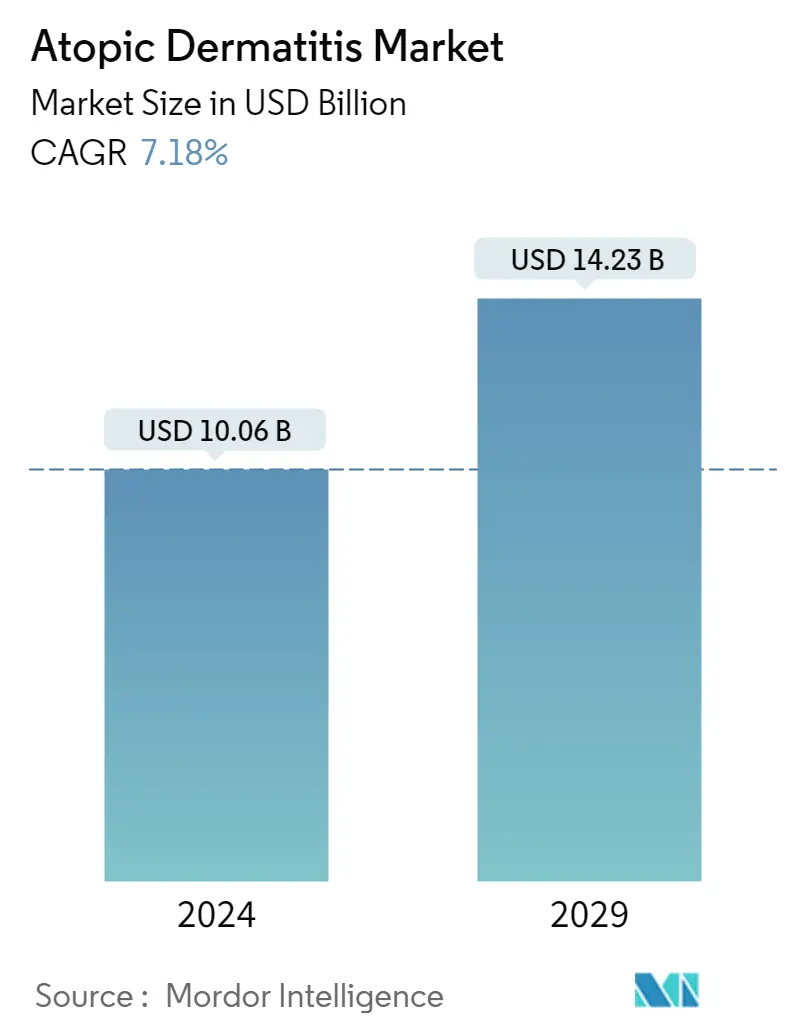Market Size of Atopic Dermatitis Industry

| Study Period | 2021 - 2029 |
| Market Size (2024) | USD 10.06 Billion |
| Market Size (2029) | USD 14.23 Billion |
| CAGR (2024 - 2029) | 7.18 % |
| Fastest Growing Market | Asia Pacific |
| Largest Market | North America |
Major Players
*Disclaimer: Major Players sorted in no particular order |
Atopic Dermatitis Market Analysis
The Atopic Dermatitis Market size is estimated at USD 10.06 billion in 2024, and is expected to reach USD 14.23 billion by 2029, growing at a CAGR of 7.18% during the forecast period (2024-2029).
- The COVID-19 pandemic significantly impacted the atopic dermatitis market. As per an NCBI article published in March 2022, atopic dermatitis is associated with an increased risk of COVID-19 infection. Also, several initiatives were introduced to manage COVID-19 patients suffering from atopic dermatitis.
- For instance, as per a June 2020 update, the SECURE-AD Patient survey is designed to help understand how the coronavirus pandemic (COVID-19) affects people with atopic dermatitis (also called atopic eczema). This survey encouraged the patient population with atopic dermatitis worldwide to participate and report their experience with COVID-19 infection. Such studies gathering the complications in patients with atopic dermatitis infected with COVID-19 provided the understanding and tolerability for various treatments of atopic dermatitis, thereby impacting the market growth. Thus, the pandemic significantly impacted the market's growth during the COVID peak stages. However, after the relaxation of strict regulations on patient consultations at healthcare centers, the current market scenario is expected to drive growth during the forecast period.
- The significant factors fueling the market's growth are the increasing burden of allergic reactions, an important role played by food allergy, and increasing environmental pollution. The growing burden of allergic reactions, with a significant role in food allergies, is driving the market's growth. For instance, Food Allergy Research and Education (FARA) report in 2020 estimated that 32 million United States residents have food allergies, including 5.6 million children under age 18. About 40% of children with food allergies are allergic to more than one food.
- Additionally, according to the Australian Society of Clinical Immunology and Allergy (ASCIA) update in May 2021, food allergy occurs in around 10% of infants, 4-8% of children, and about 2% of adults in Australia and New Zealand. Moreover, according to an article published in Nutrition Today Journal in February 2020, food allergy is a significant public health issue. It affects an estimated 3% to 10% of adults and 8% of children worldwide.
- Likewise, accoring to a National Center for Biotechnology Information (NCBI) article in June 2020, infants with temporary skin barrier disruption and persistent atopic dermatitis are particularly at risk of developing food allergies. Among them, severe cases of atopic dermatitis with positive symptoms were observed in one-third of patients in an oral food challenge. As per the same study, many children with atopic dermatitis exhibit asymptomatic sensitization to foods. As food allergies result in atopic dermatitis, the increasing burden of allergic reactions across the globe is anticipated to increase the demand for treating atopic dermatitis worldwide, propelling the market growth.
- Additionally, the regulatory authorities approvals are propelling the market's growth. For instance, in December 2021, LEO Pharma Inc. reported that the United States Food and Drug Administration (USFDA) approved Adbry (tralokinumab-Adam) for treating moderate-to-severe atopic dermatitis in adults 18 years or older.
- Thus, the market is expected to show growth over the forecast period due to the abovementioned factors, such as the increasing burden of allergic reactions and product approvals. However, severe adverse effects of certain therapeutic drugs significantly hinder the market's growth.
Atopic Dermatitis Industry Segmentation
As per the scope of this report, atopic dermatitis, also known as atopic eczema, is often related as just a 'skin condition,' a misconception people think can be dealt with on their own. However, it impacts the patient's life physically and emotionally.
The atopic dermatitis market is segmented by drug class (corticosteroids, emollients/moisturizers, il-4 and pde4 inhibitors, calcineurin inhibitors, antibiotics, and other drug classes), route of administration (topical, oral, and injectable), and geography (North America, Europe, Asia-Pacific, Middle-East and Africa, and South America).
The market report also covers the estimated market sizes and trends for 17 countries across major global regions. The report offers the value (USD million) for the above segments.
| By Drug Class | |
| Corticosteroids | |
| Emollients/Moisturizers | |
| IL-4 and PDE4 Inhibitors | |
| Calcineurin Inhibitors | |
| Antibiotics | |
| Other Drug Classes |
| By Route of Administration | |
| Topical | |
| Oral | |
| Injectable |
| Geography | ||||||||
| ||||||||
| ||||||||
| ||||||||
| ||||||||
|
Atopic Dermatitis Market Size Summary
The atopic dermatitis market is poised for substantial growth over the forecast period, driven by a combination of increasing allergic reactions, environmental factors, and regulatory approvals. The market's expansion is further supported by the rising prevalence of food allergies, which are closely linked to atopic dermatitis, and the growing demand for effective treatments. The COVID-19 pandemic initially disrupted the market, but subsequent studies and patient surveys have provided valuable insights into managing atopic dermatitis in infected individuals, thereby aiding market recovery. The approval of new therapies by regulatory authorities, such as the USFDA, has also contributed to the market's positive outlook, with corticosteroids expected to play a significant role due to their long-standing efficacy in treating inflammatory skin conditions.
North America, particularly the United States, is anticipated to hold a significant share of the atopic dermatitis market, fueled by high treatment awareness, a robust healthcare infrastructure, and early adoption of novel medications. The region's growth is further bolstered by favorable reimbursement policies and strategic partnerships between pharmaceutical companies and research organizations. The competitive landscape is characterized by the presence of major players like Pfizer Inc., Novartis International AG, and Abbvie Inc., which intensifies market rivalry. These companies are actively involved in product developments and awareness campaigns, contributing to the market's dynamic nature. Overall, the atopic dermatitis market is expected to witness significant growth, driven by increasing demand for effective treatments and ongoing innovations in the field.
Atopic Dermatitis Market Size - Table of Contents
-
1. MARKET DYNAMICS
-
1.1 Market Overview
-
1.2 Market Drivers
-
1.2.1 Increasing Burden of Allergic Reactions with Major Role of Food Allergy
-
1.2.2 Increasing Environmental Pollution
-
-
1.3 Market Restraints
-
1.3.1 Serious Adverse Effects Related to Certain Therapeutic Drugs
-
-
1.4 Porter's Five Forces Analysis
-
1.4.1 Threat of New Entrants
-
1.4.2 Bargaining Power of Buyers/Consumers
-
1.4.3 Bargaining Power of Suppliers
-
1.4.4 Threat of Substitute Products
-
1.4.5 Intensity of Competitive Rivalry
-
-
-
2. MARKET SEGMENTATION (Market Size by Value - USD million)
-
2.1 By Drug Class
-
2.1.1 Corticosteroids
-
2.1.2 Emollients/Moisturizers
-
2.1.3 IL-4 and PDE4 Inhibitors
-
2.1.4 Calcineurin Inhibitors
-
2.1.5 Antibiotics
-
2.1.6 Other Drug Classes
-
-
2.2 By Route of Administration
-
2.2.1 Topical
-
2.2.2 Oral
-
2.2.3 Injectable
-
-
2.3 Geography
-
2.3.1 North America
-
2.3.1.1 United States
-
2.3.1.2 Canada
-
2.3.1.3 Mexico
-
-
2.3.2 Europe
-
2.3.2.1 Germany
-
2.3.2.2 United Kingdom
-
2.3.2.3 France
-
2.3.2.4 Italy
-
2.3.2.5 Spain
-
2.3.2.6 Rest of Europe
-
-
2.3.3 Asia-Pacific
-
2.3.3.1 China
-
2.3.3.2 Japan
-
2.3.3.3 India
-
2.3.3.4 Australia
-
2.3.3.5 South korea
-
2.3.3.6 Rest of Asia-Pacific
-
-
2.3.4 Middle East and Africa
-
2.3.4.1 GCC
-
2.3.4.2 South Africa
-
2.3.4.3 Rest of Middle East and Africa
-
-
2.3.5 South America
-
2.3.5.1 Brazil
-
2.3.5.2 Argentina
-
2.3.5.3 Rest of South America
-
-
-
Atopic Dermatitis Market Size FAQs
How big is the Atopic Dermatitis Market?
The Atopic Dermatitis Market size is expected to reach USD 10.06 billion in 2024 and grow at a CAGR of 7.18% to reach USD 14.23 billion by 2029.
What is the current Atopic Dermatitis Market size?
In 2024, the Atopic Dermatitis Market size is expected to reach USD 10.06 billion.

